Sidney Yankauer
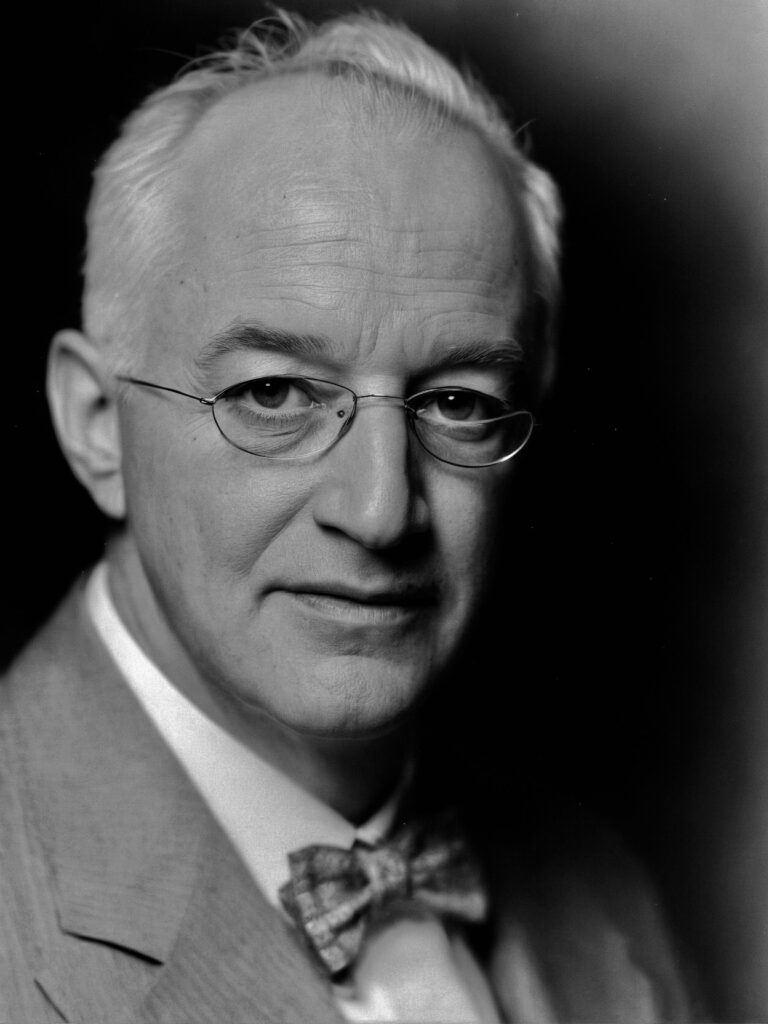
Sidney Yankauer (1872–1932) was an American otolaryngologist.
Dr Sidney Yankauer was a pioneering American otolaryngologist renowned for his surgical dexterity and for inventing the Yankauer suction catheter, a staple of airway management still in use today. A New York native, Yankauer trained at the College of the City of New York and Columbia University’s College of Physicians and Surgeons before beginning a distinguished career at Mount Sinai Hospital.
In 1905, he performed the first successful bronchoscopy in New York City to remove a foreign body. He became Director of the Laryngology Service in 1917, transforming it into a prominent academic department. He invented numerous surgical instruments, pioneered bronchoscopy and airway surgery, and was active in military medicine during World War I. He also established a dedicated Tonsil and Adenoid ward and explored novel approaches to cancer treatment with radium.
Yankauer’s legacy combines technical brilliance, anatomical research, and enduring clinical innovation. His skill, ingenuity, and contributions to ENT surgery continue to influence practice globally.
Biography
- Born on March 27, 1872 in New York City, New York
- 1890 – Graduated from City College of New York
- 1893 – Graduated from the College of Physicians and Surgeons; internship at Mount Sinai Hospital
- 1893–1917 – Appointed to the Surgery Clinic of the Outpatient Department at Mount Sinai
- 1904 – Designed the Yankauer ether/chloroform mask
- 1905 – Performed the first successful bronchoscopy in New York City
- 1907 – Designed the Yankauer sucker
- 1916 – President of the Mount Sinai Alumni Association
- 1917 – Director of the Laryngology Service at Mount Sinai Hospital; granted six-bed surgical unit status.
- 1918 – Established dedicated Tonsil and Adenoid ward, Mount Sinai Hospital
- 1918-1919 Served as a major for the United States Army in France; Mount Sinai Base Hospital No. 3 in France
- 1920 – Reported five-year cures in patients with laryngeal cancer treated via combination surgery and radiotherapy
- 1925 – Reported bronchoscopic treatment in 400 lung abscess patients using over 3,000 endoscopic irrigations
- 1926 – Proposed improved method for applying radium in oesophageal cancer
- 1928 – President of the American Bronchoscopic Society
- Died on August 27, 1932 of heart disease at Mount Sinai hospital
Medical Eponyms
Yankauer mask (1904) [Yankauer-Gwathmey Mask]
The mask was simple in design and had a wire mesh to place gauze on; liquid anaesthetic such as chloroform could then be placed on the gauze. The mask also had a gutter to catch surplus liquid anaesthetic. The mask was modified by Gwathmey to allow the administration of oxygen alongside the anaesthetic.
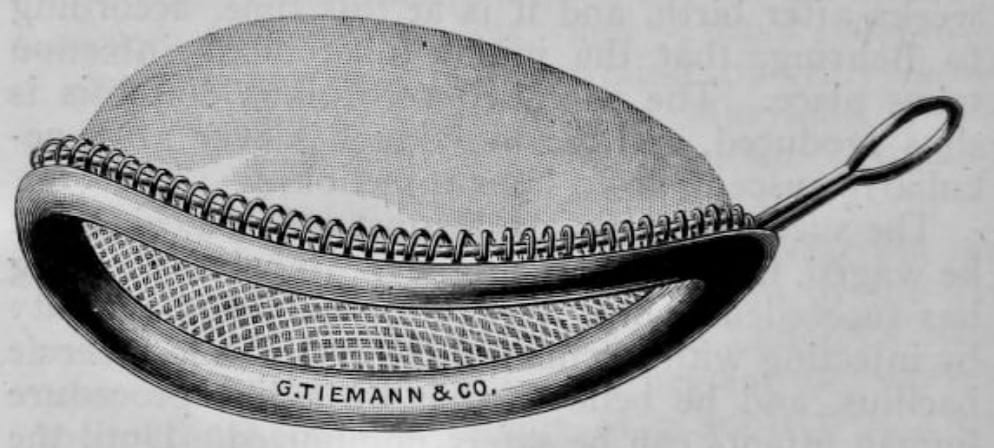
The chloroform mask herewith presented has two new features which render it of special value. The body of the mask consists of a framework of wire netting, instead of the one or two wires usually arranged for the support of the gauze covering the mask. This wire netting comes in contact with the gauze and supports its entire surface, thus preventing it from flapping back and forth with respiration, and from coming in contact with the nose and cheeks. The edge of the wire netting is continued into a metal gutter, shaped to fit the face, which turns up the edge of the gauze and prevents this from touching the skin. By keeping the gauze saturated with chloroform away from the skin a ” chloroform burn ” cannot occur, as the vapor of chloroform does not blister the skin.
Yankauer 1904
Yankauer suction catheter (1907)
The Yankauer’s suction catheter is most probably the commonest suction device used in modern medicine. However an original description/publication of Yankauer’s suction catheter is not found within the literature.

The suction catheter was initially designed to keep a surgical field clear and was intended for use during tonsillectomies. Its rose end helped to prevent soft tissue damage whilst its curved angle helped provide a good view for its placement.
Yankauer laryngeal medicator (1907)
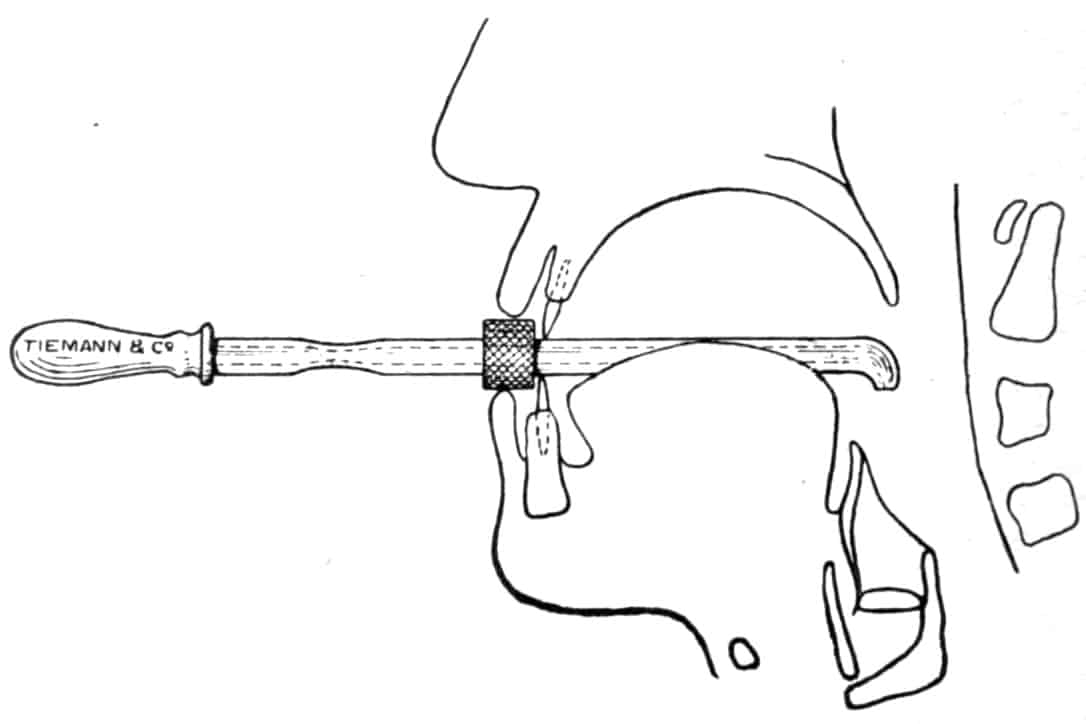
At the request of Dr. George Mannheimer, an internist of Mount Sinai Dispensary, I devised this little apparatus for the especial purpose of enablng tuberculous patients to make applications of thick and viscid fluids (orthoform emulsion) to the larynx at their own homes. The device has proven so efficient that I have extended its use to the self-treatment of other laryngeal conditions with entire satisfaction.
It consists of a strong glass tube, bent at right angles at one end, slightly flattened near the other end, and fitted with a small rubber bulb holding about 3ij.
Yankauer 1907
Yankauer Speculum (1911)
Yankauer Speculum for the Direct Examination and Treatment of the Nasopharynx and Eustachian Tubes.
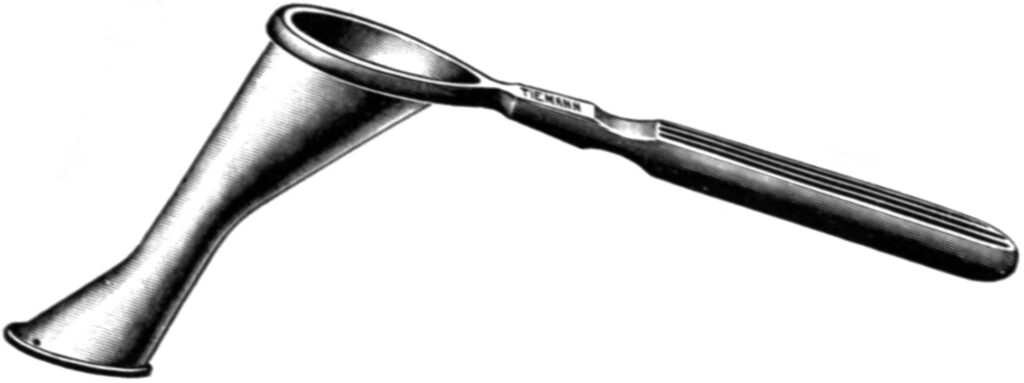
This speculum consists of a tube of a peculiar shape which is introduced into the nasopharynx, and illuminated by means of the ordinary head-light. It acts as a palate lifter, and as the anterior wall of that part which lifts the palate is on a straight line with the posterior wall of the part which presses the mouth back, it enables us to bring into view the orifice of the eustachian tube and part of its anterior wall.
Yankauer 1911
Yankauer surgical instruments (1917)
Yankauer designed myriad instruments for surgical operations, some of which are outlined in Loeb’s Operative surgery of the nose, throat, and ear, for laryngologists, rhinologists, otologists, and surgeons. 1917. A selection are detailed below
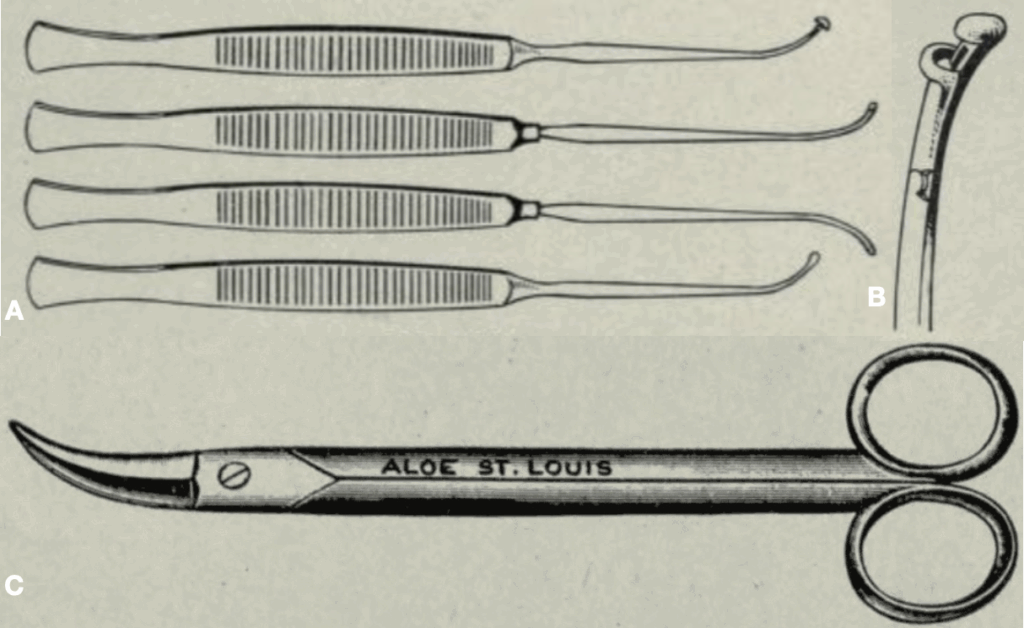
B. Yankauer’s antrum punch
C. Yankauer’s tonsil scissors punch
Yankauer suction and pressure anesthesia pump (1920)
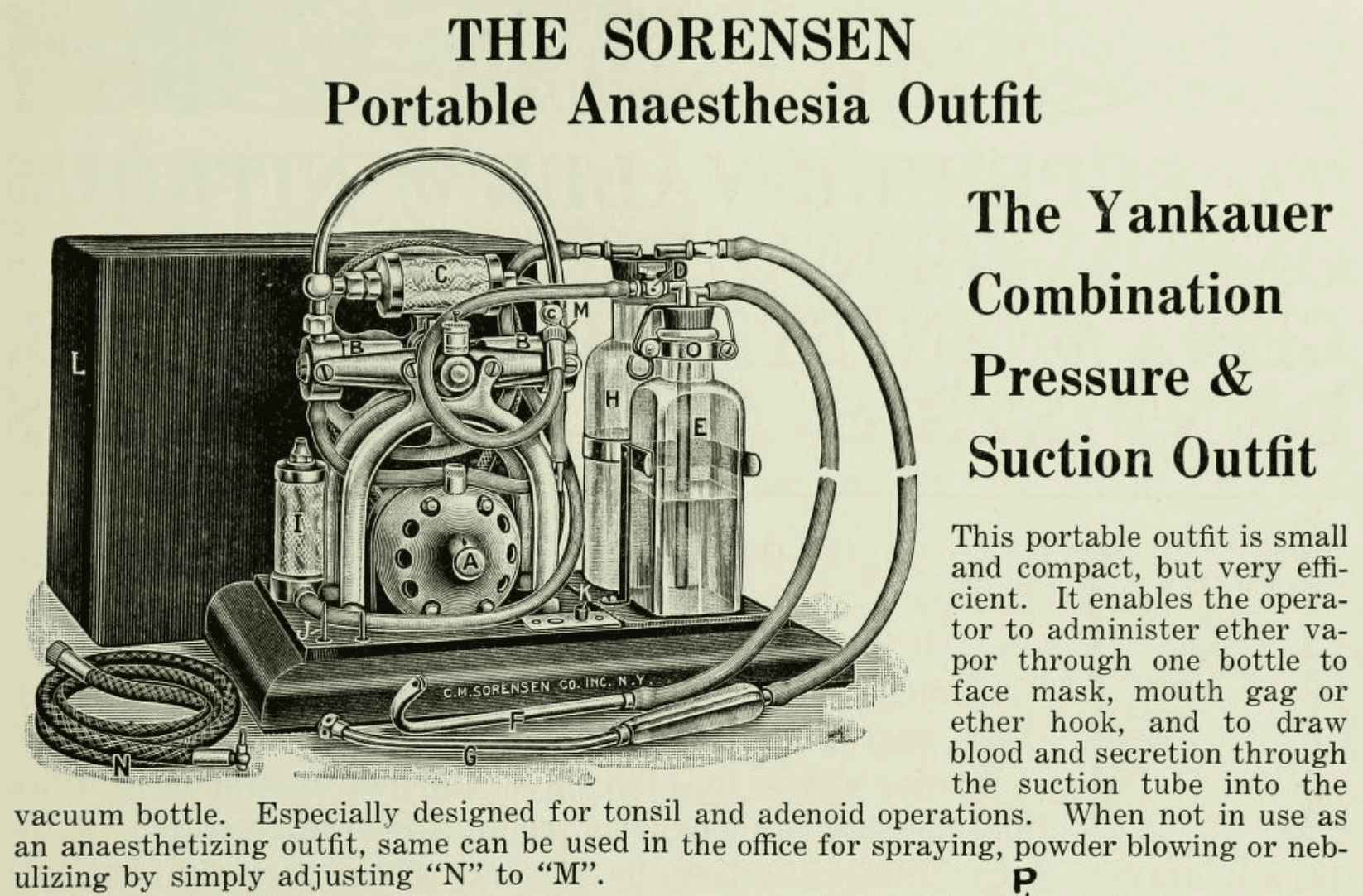
The Yankauer suction and pressure pump allowed for the simultaneous administration of ether whilst allowing for suction at the same time. One tube was used to pump ether anaesthetic into the patients mouth, whilst at the same time a Yankauer catheter provided suction.
Major Publications
- Yankauer S. Clinical Thermometer. 1899. United States Patent Office. Patent number 626124
- Yankauer S. A new chloroform mask. The New York Medical Journal and Philadelphia Medical Journal 1904; 79(23): 1114 [Yankauer mask]
- Yankauer S. A leech in the trachea, report of two cases. Laryngoscope 1904; 14(7): 567
- Yankauer S. Foreign body in the bronchus: removal with the aid of the bronchoscope: recovery. Medical Record 1905; 67: 217
- Yankauer S. A laryngeal medicator for the patient’s use. Laryngoscope 1907; 17(8): 658-659
- Yankauer S. Tonsillectomy. The Laryngoscope 1909: 19(5): 329-339
- Yankauer S. The isthmus of the eustachian tube: a contribution to the pathology and treatment of middle-ear diseases, 1909
- Yankauer S. A Speculum for the Direct Examination and Treatment of the Nasopharynx and Eustachian Tubes. Transactions of the American laryncological, rhinological and otological society. 1911: 302
- Yankauer S. A New Direct Laryngoscope. Transactions of the American laryncological, rhinological and otological society. 1911: 311
- Yankauer S. The complete spheno-ethmoid operation. Laryngoscope 1921; 31(11): 831-842
- Yankauer S. A radium needle for the esophagus. Archives of Surgery 1923; 5: 288
- Yankauer S. Bronchoscopy in the treatment of lung abscess. Surgical Clinics of North America 1925; 5: 525-530
- Yankauer S. Resilient Wheel. 1923. United States Patent Office. Patent number 1,459,565
- Yankauer S. Pipe Lighter. 1931 United States Patent Office. Patent number 1,834,756
References
Biography
- Sidney Yankauer: Draft, enlistment and service. New York, U.S., Abstracts of World War I Military Service, 1917-1919 [Date of Birth]
- In memoriam. Dr. Sidney Yankauer. The Laryngoscope 1932; 42(10): 818-820
- In memoriam. Sidney Yankauer. Bull N Y Acad Med. 1932 Sep; 8(9): 591
- Smith T. Sidney Yankauer – the man behind the mask. The History of Anaesthesia Society Proceedings. 2012; 45: 73–77
- Archive Image: [Sidney Yankauer]. US National Library of Medicine
- Aufses AH Jr, Niss BJ. This House of Noble Deeds: The Mount Sinai Hospital, 1852-2002. 2002: 279-280
Eponymous terms
- Loeb HW. Operative surgery of the nose, throat, and ear, for laryngologists, rhinologists, otologists, and surgeons. 1917
- Yankauer Masks. Wood Library Museum
- Advertisement. The Yankauer Combination Pressure and Suction Outfit. American Year-Book of Anesthesia and Analgesia 1917-1918: ii
Eponym
the person behind the name
Doctor currently working in South Wales, training in anaesthetics. Graduated Leeds University with MB ChB with BSc in microbiology in relation to medicine. Special interests in emergency medicine, critical care and anaesthetics
Dr. Geoffrey Jara-Almonte, MD is an Assistant Professor of Emergency Medicine at New York City Health and Hospitals Elmhurst Hospital Center and the Icahn School of Medicine at Mount Sinai. He is Assistant Program Director for the Emergency Medicine Residency at Mount Sinai Hospital. His academic focus is medical education with particular focus on resident mentorship, feedback, assessment and curricular design | Sinai EM |


